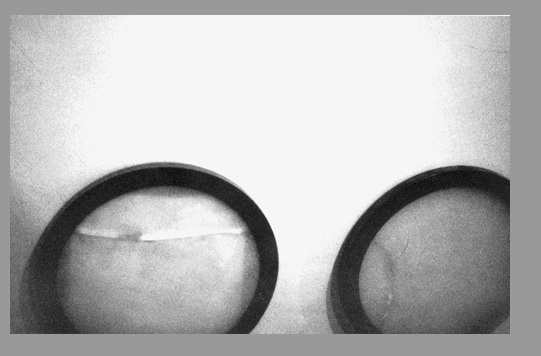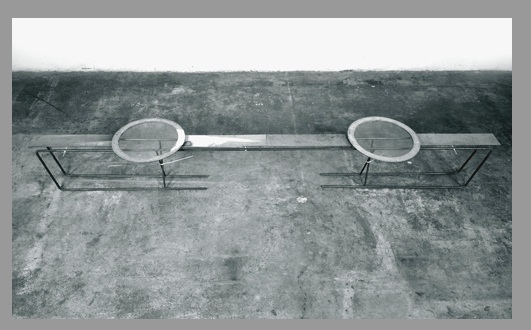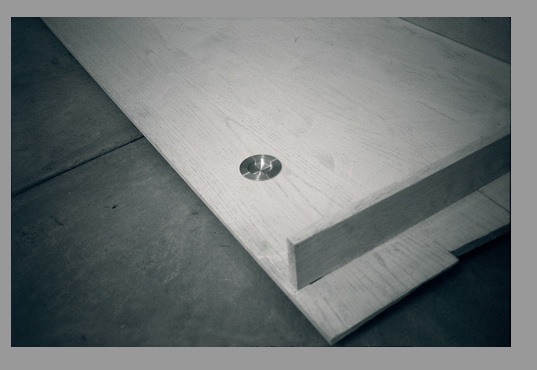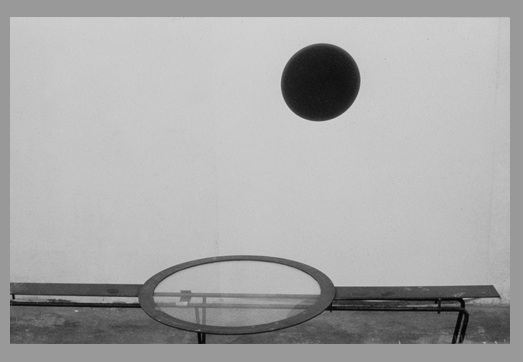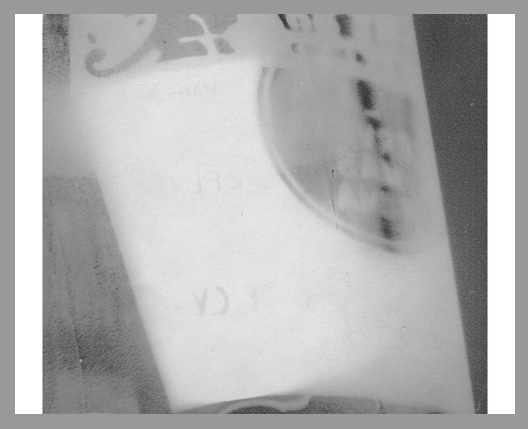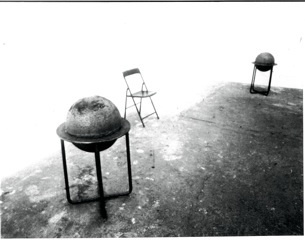BRIAN GAMAN
Brian Gaman once tried to make eyeglass lenses by casting the glass himself. They cracked; he left them unpolished. He kept the bridge and arms off the frame, leaving just two black-rimmed circles. And oh yes, did I mention, he made them nearly two feet high each? They lean casually against the wall. You would never guess their true identity. Likewise another pair of spectacles also from the late 80’s, just as impaired, with a cataract of nylon mesh across the lenses. This time the frame is complete but disguises itself as a Jean Prouve-style bench or coffee table. The steel legs fold under and in, the structure ready to be put away or taken out of a hypothetical carrying case. All these clues to its identity and still this shape is slow to announce itself as eyewear, nor does the title allude to such a thing; nevertheless, once you “see” the sculptures as pairs of glasses it is like the hag in the drawing of the beautiful woman—that old chestnut of a perceptual double-entendre. Easy to miss but having seen it you can’t unsee it. So too once you take in Gaman’s blinkers the ghosts of Harold Lloyd and Fitzgerald’s T. J Eckleburg, the optician whose sign hangs over the famously symbolic ash heap, never depart from Gaman’s work. Comedy and dread, inextricable, an aversion to certainties and warranties, produce what Alexander Nemerov has called “an existential standoff.” These works, despite their shy claims, pun on Gaman’s long-term goal, to enlarge the field of vision. Trouble is –like all the best artists—Gaman is bedeviled by a dybbuk of doubt. So everything attempted must be undone or effaced. Sometimes you can even spend time watching the vanishing, as in the 1970’s video he made tracking the shrinking into a dot and subsequent disappearance over the horizon of a friend running away into the desert.
Dots and circles are everywhere in the work—floaters of shortsightedness or spots in front of eyes strained by looking into the sun. At Yale in grad school Gaman was interested in artists concerned with the gap between knowing and saying. That means neither knowing nor saying. So the work is terse bordering on mute—hence the difficulty of discovering that occasionally those spheres are actually bubbles of hilarity, hiccups escaping from a Beckettian black humor hole. Indeed, inebriation is the genesis of pieces from the late 90’s. Having made a series of inverted tables, including one with a ROUND aluminum cup for the gum that would normally be stuck underneath, he developed a “parallel pictorial item for what would happen on those tables.” He put beer bottles on photo sensitive paper, scanned in the image to files and enlarged it to 36 “x 44”, in other words, expanded the visual field to the threshold of incomprehensibility. Blind drunk. Not to mention that beer bottles leave rings on tables. He is literally making a point, or a series of points. If the point is warped by, say, its own peripheral vantage that’s part of the fun: when is a point not a point? Ultimately, however, looking at a silver print photo of a black circle, 50 inches by 94 inches, distorted so that the edges go in and out of focus, the humor has dried up to a speck and blown over into the land of minimalist gravitas.
For a certain generation of sculptors conscription into the minimalist army required some deft draft dodging. Gaman’s strategy, not surprisingly, turned out to be a sort of neither/nor impulse. Neither the ephemerality of Irwin’s optics—despite an ongoing concern with opticality—nor the clenched fist of Serra’s panzer brut, despite the heavy use of iron and often rusted steel. Instead he produces a “strong misreading,” an ironic collapse of antithetical terms, rendering the iconography of ethereal perception in iron.
Somehow this seems like what would happen if you persistently took the long view of things. Maybe that’s why, from the long view, an icon of forward-looking modernist furniture design will seem antiquated, rusted. And maybe that’s why in 1987 Gaman turned to making globes, literally “iron-bound,” as well as featureless. You need a distant perspective to see the world whole. These worlds, saturnine, and in fact ringed, are more often than not shown in pairs and are as flinty, stony-eyed and blank as the orbs of blind Tiresias. Would it be fanciful to say they apply the seer’s doom to world affairs? Perhaps. After all the globes are emphatically simple shapes, suggestive rather than specific. But what of that other most recent curve? This time so small a segment of so large a circle as to appear almost flat. Christopher Columbus! Four of these are presently underway, made of thin cast aluminum, a metal, but lighter. It is as though to be farsighted and so able to see the world as a whole is to be philosophical, historical, but iron-bound and reductive; to be nearsighted, peering so closely at only the smallest of areas is to be IN IT, phenomenological, experiential but also astigmatic and distorted, like so many of Gaman’s printed black circles. Near and far, of the moment and of history—this dialectic continues to inform Gaman’s enterprise. And so presently he is scanning old drawings and printing out a few pixels to heights of seven or eight feet (the results, however, are far from pixilated). He is appropriating corporate logos and ads from the business section of newspapers featuring images of infinity in the form of endless water or sky, tilting them, of course, to skew the perspective. In a “purpose-driven, achievement-obsessed” world, Gamon’s economy is Spartan. Deadpan. It’s a little like hearing this phrase come out of Lloyd’s straight, affectless face: “Jeepers, creepers wher’d ya get them peepers?”
Howard Foster
